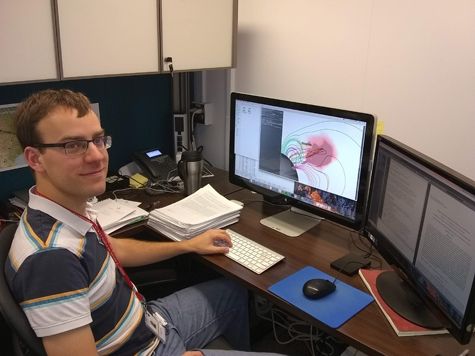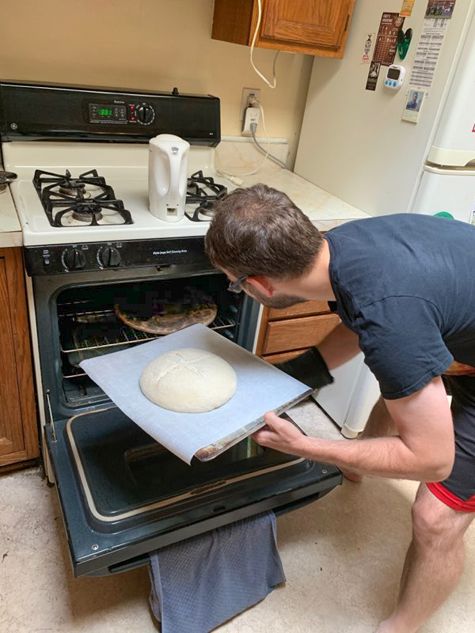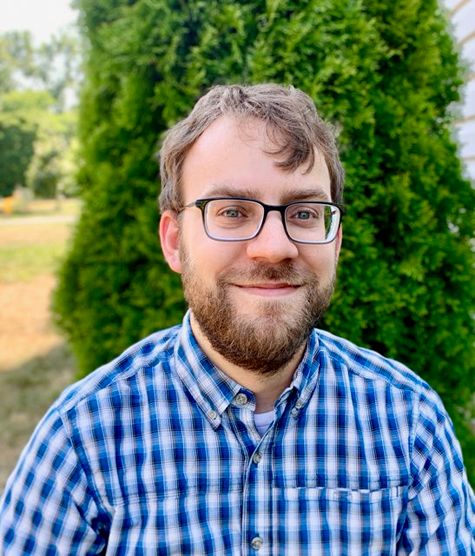Early Career Scientist Spotlight
Dr. Joel Dahlin (he/him/his)
Solar Physicist
Heliophysics Science Division (670)
What inspired you to pursue a career in solar physics?
I always loved numbers growing up – I was the sort of kid who would jot down math problems instead of doodling. My introduction to physics was in high school – it didn’t have much of a physics curriculum, but I ended up taking a crash-course through the official textbook in order to take the International Baccalaureate exam and I was intrigued. I planned to be a math major at Wheaton College, but after a physics course my first year, I picked up the double major and discovered quickly it was more up my alley. Summer plasma physics research at the Wheaton Impulsive Reconnection eXperiment (“if it WIRX, don’t fix it!”) introduced me to the exciting topic of magnetic reconnection -- essentially, the study of magnetic explosions – that has ever since been the common theme in my research. My summer involved experimental work (e.g., machining a mount for a high-speed camera), which I came to recognize was not quite my skillset. Nevertheless, my appetite for physics research was whetted. From there, I knew I wanted to keep studying in graduate school. An offer of a research position with Jim Drake’s theory group at the University of Maryland became a gateway to studying magnetic reconnection in space and especially on the sun! Growing up I never pictured or dreamt of the idea of working at NASA. I had a bit of a contrarian spirit and didn’t want to copy everyone else’s dream! But space beckons us all it seems, and I couldn’t be happier that this is where I ended up.
Tell us about the research projects you are currently working on.
I work, broadly, on numerical simulations of solar eruptive events. These represent the largest explosions in the solar system and usually consist of two parts: solar flares, which are the bright, transient flashes (especially in X-rays, extreme ultraviolet, and radio) at the sun, and accompanying coronal mass ejections (“a billion tons at a million miles an hour”). Both represent significant space weather hazards to spacefaring humans and technology. In order to tackle these questions, I run simulations on NASA supercomputers, at times occupying thousands of computational cores at a time and generating many terabytes of data.
My research projects generally fall into two topic areas related to solar eruptive events. One important aspect is understanding how the energy to power these tremendous explosions is stored up in the first place. We know that the energy comes from highly stressed magnetic structures known as filament channels. These structures often support cool plasma above the surface of the sun, showing up as bright prominences when they stretch away from the disk of the sun, or as filaments, which are dark streaks across the disk. One of the ideas I am exploring is that of “helicity condensation” – the idea that these structures form slowly over time from the collective churning of the many convection cells (granules and supergranules) that blanket the sun. An analogy (not a perfect one!) for this idea would be the rings that form in a pot as sauce boils and evaporates.
Another key area of research relates to how the energy is released in flares at the sun. We know from the hard X-rays and radio waves they emit that a spectacular particle acceleration takes place, but the details of how it happens can be quite elusive as the magnetic field dynamics involved are hard to observe and image, at least directly. In order to tackle this data gap, I’ve worked on numerical models to derive insight into this structure using indirect observations of the magnetic structure: “flare ribbons” (patches in the solar chromosphere illuminated by the high-energy particle beams traveling along the magnetic field) and “flare loops” (hot magnetic loops left behind by the explosion that powers the flare).

Credit: NASA's Goddard Space Flight Center/SDO
How did you end up working at NASA Goddard?
While nearing the end of my graduate studies, I was at a conference where I met Spiro Antiochos of GSFC and was excited by his interesting work on reconnection in solar flares. In graduate school I had been working on the microphysics problem of how particles are accelerated in reconnection, and his research group was working in part on the large-scale problem. It seemed obvious I should try to figure out how to connect the two viewpoints of these flares. I applied to be a Jack Eddy Fellow under that premise, and that began my journey at NASA GSFC. I was awarded that fellowship and have worked at GSFC ever since.
What aspects of your work are you most passionate about?
In my practical day-to-day I’m pretty excited when I get my hands on some new simulation data. I’m like a kid in a candy store trying out new and different ways to draw meaning from the data. The depth of specialization required to press at the frontiers of science can at times raise communication barriers between different subfields. I therefore relish the challenge of turning numbers into pictures that communicate a clear idea to as many colleagues as I can.
In a broader sense, I’m passionate about getting to know the interesting and diverse people who are my colleagues – I enjoy hearing about different stories and ways of doing science. I find myself stretched and enriched through the experience. It can be hard to tear my eyes away from whatever paper or simulation or project or proposal I’m working on, but connections with people are invariably rewarding.

Credit: Joel Dahlin
What research accomplishment are you most proud of?
A few years ago, I was awarded the Ronald C. Davidson award for Plasma Physics in recognition of a paper I authored as a graduate student. I remember being pretty surprised – I read a lot of papers that seemed more technically impressive or sophisticated. As with many such awards, it reflected a team effort – strong advising, a good research plan, and the right timing. Nevertheless, I took it as validation that my favorite approach to research– simple figures, big ideas, and boiling things down to the essentials – could be an effective strategy for science progress.
What do you like to do in your free time?
I enjoy cooking and baking, especially for other people! The pandemic put a pretty strong damper on that, but it inspired me to pick up a hobby of bread-baking. It was a great way to scratch that hospitality itch – saying a brief hello in the safe outdoors and leaving an appreciated gift to be remembered by.

Credit: Joel Dahlin
What early career advice do you have for those looking to do what you do?
One of the most important things I’ve learned in my career so far is the idea of finding my niche and leaning into it. I quickly discovered that I was a modeler/theorist at heart, but I puzzled why I was not all that excited about chasing down careful proofs with many lines of algebra. I have thought at times that was a flaw, but I’ve come to grasp that different scientists have different strengths and affinities, and in this teamwork-driven era I’ve found it best to lean into what I enjoy doing and am good at rather than trying to put myself in someone else’s box. Broad skillsets are often valuable to cultivate, and sometimes projects (or advisors) won’t afford you all that much flexibility. However, I would encourage early careers give themselves space where able to cut their own path and find their own niche. I’d also encourage finding ways to meet with and interact with others – to attend summer schools (many of them are mostly funded), get to know their graduate cohorts, to seek friendships among diverse colleagues, and to help those coming along behind.
Biography
Home Town:
Valle de la Pascua, Venezuela
Undergraduate Degree:
BA in Math and Physics, Wheaton College, Wheaton, IL
Post-graduate Degrees:
PhD in Physics, University of Maryland, College Park, MD

